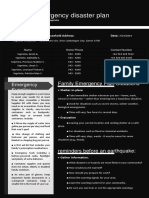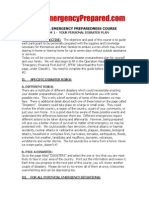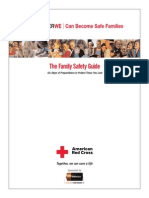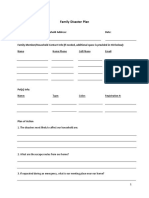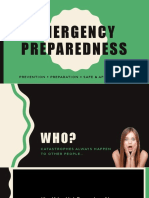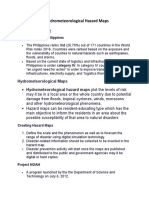Calamity and Disaster Preparedness
Uploaded by
Enamithce BendanilloCalamity and Disaster Preparedness
Uploaded by
Enamithce BendanilloCalamity and Disaster Preparedness
Objectives:
1. Describes the historical background of disaster
preparedness:
2. Enumerate the objectives or the National Calamity and
Disaster Plan and discuss its Concept;
3.Explain the various disaster coordinating councils:
4. Enumerate and explain preparations in case of disaster;
and
5. Describe the steps for disaster preparedness.
Guide questions for group sharing:
1. What is disaster? Why?
2. What is Disaster Preparedness?
3. What are the common types of Natural or man made
disaster?
4. What are the general effects of disaster?
5. What are the approaches to disaster management?
6. What to have?
A disaster is an event, natural or man made, sudden or
progressive, which impacts with such severity that the
affected community has to respond by taking exceptional
measures.
It is a serious disruption of the functioning of a society
causing widespread human, material, financial, and
environmental losses which exceed the ability of the
society to cope using its own resources.
Philippines is oftentimes subjected to different natural
disasters and calamities because we are surrounded by
water. The country is an archipelago composed of more
than 7,000 islands.
These ocean and seas that surround us are also
considered blessings because they are sources of marine
wealth.
What are the common types of disaster?
The different disasters that Filipinos experience are:
❖ Earthquake
❖ Volcanic eruption
❖ Tsunami
❖ Tropical cyclone
❖ Flood
❖ Landslide
❖ Bushfire
❖ Drought
❖ Epidemic
❖ Major Accident
❖ Armed conflict and civil unrest
TERRORISM?
What can you do to prepare?
Finding out what can happen is the first step. Once you
have determined the events possible and their potential in
your community, it is important that you discuss them with
your family or household. Develop a disaster plan together.
1. Create an emergency communications plan. Choose an out-
of- town contact your family or household will call or e-mail to
check on each other should a disaster occur. Your selected
contact should live far enough away that they would be unlikely
to be directly affected by the same event, and they should know
they are the chosen contact. Make sure every household
member has that contacts, and each other's, e-mail addresses
and telephone numbers (home, work, pager and cell). Leave
these contact numbers at your children's schools, if you have
children, and at your workplace. Your family should know that if
telephones are not working, they need to be patient and try
again later or try e-mail. Many people flood the telephone lines
when emergencies happen but e-mail can sometimes get
through when calls don't.
2. Establish a meeting place. Having a predetermined
meeting place away from home will save time and
minimize confusion should your home be affected or the
area evacuated. You may even want to make
arrangements to stay with a family member or friend in
case of an emergency. Be sure to include any pets in these
plans, since pets are not permitted in shelters and some
hotels will not accept them.
3. Assemble a disaster supplies kit If you need to evacuate your
home or are asked to "shelter in place", having some essential
supplies on hand will make you and your family more
comfortable. Prepare disaster supplies kit in an easy-to-carry
container such as a duffel bag or small plastic trash an. Include
"special needs" items for any member of your household (infant
formula or items for people with disabilities or older people), first
aid supplies (including prescription medications), a change of
clothing for each household member, a sleeping bag or bedroll
for each, a battery powered radio or television and extra
batteries, food, bottled water and tools. It is also a good idea to
include some cash and copies of important family documents
(birth certificates, passports, and licenses) in your kit.
Copies of essential documents -like powers of attorney, birth and
marriage certificates, insurance policies, life insurance beneficiary
designations and a copy of your will- should also be kept in a safe
location outside your home. A safe deposit box or the home of a friend or
family member who lives out of ton is a good choice.
4. Check on the school emergency plan of any school-age children you
may have You need to know if they will keep children at school until a
parent or designated adult can pick them up or send them home on their
own. Be sure that the school has updated information about how to reach
parents and responsible caregivers arrange for pick up. And, ask what
type of authorization the school may require to release a child to
someone you designate, if you are not able to pick up your child. During
times of emergency the school telephones may be overwhelmed with
calls.
IF DISASTER STRIKES
❖ .Remain calm and be patient.
❖ Follow the advice of local emergency officials .
❖ Listen to your radio or television for news and instructions
❖ If the disaster occurs near you, check for injuries. Give the first
aid and get help for seriously injured people. If the disaster
occurs near your home while you are there, check for damage
using a flashlight. Do not light matches and candles or turn of
electrical switches. Check for fires, fire hazards and other
household hazards. Sniff for gas leaks, starting at the water
healer. If you smell gas or suspect a leak, turn off the main gas
valve, open windows, and get everyone outside quickly.
❖ Shut off any other damaged utilities .
❖ Confine or secure your pets.
❖ Call your family contact do not use the telephone again
unless it is a life threatening emergency.
❖ Check on your neighbors, especially those who are
elderly or disabled.
A WORD ON WHAT COULD HAPPEN
As we learned from the events of September 11, 2001, the following things can happen after a
terrorist attack:
❖ .There can be significant numbers of casualties and/or damage to buildings and the
infrastructure. So employers need up-to-date information about any medical needs you may
have and on how to contact your designated beneficiaries.
❖ .Heavy law enforcement involvement at local, state and federal levels follows a terrorist attack
due to the event's criminal nature.
❖ Health and mental health resources in the affected communities can be strained to their limits
maybe even overwhelmed
❖ Extensive media coverage, strong public fear and international implications and
consequences can continue for a prolonged period.
❖ Workplaces and schools nay be closed, and there may be restrictions on domestic and
international travel.
❖ You and your family or household may have to evacuate an area, avoiding roads blocked for
your safety.
❖ Clean-up may take many month
Evacuation
If local authorities ask you to leave your home, they have a
good reason to make this request, and you should heed
the advice immediately. Listen to your radio or television
and follow the instructions of local emergency officials and
keep these simple tips in mind:
❖ Wear a long-sleeved shirts, long pants and sturdy shoes
so you can be protected as much as possible.
❖ Take a disaster supplies kit.
❖ Take you pets with you; do not leave them behind.
Because pets are not permitted in public shelters, follow
your plan to go to a relative's or friend's home, or find a
"pet friendly" hotel.
❖ Lock your home.
❖ Use travel routes specified by local authorities - don't use
shortcuts because certain areas may be impassable or
dangerous.
❖ Stay away from downed power lines.
Listen to local authorities:
Your local authorities will provide you with accurate
information specific to an event in your area. Staying tuned
to local radio and television, and following their instructions
is your safest choice.
lf you're sure you have time:
❖ Call your family contact to tell them where you are going
and when you expect to arrive.
❖ Shut off water and electricity before leaving, if instructed
to do so. Leave natural gas service OFF unless local
officials advise you otherwise. You may need gas for
heating and cooking, and only a professional can restore
gas service in your home once it's been turned off. In a
disaster situation, it could take weeks for a professional
to respond.
Shelter-in-place fact Sheet
If you are advised by local officials to "shelter in place", what they
mean is for you to remain inside your home or office and protect
yourselves there. Close and lock all windows and exterior doors. Turn
off all fans, heating and air conditioning systems. Close the fireplace
damper. Get your disaster supplies kit, and make sure the radio is
working. Go to an interior room without windows that's above ground
level. In the case of a chemical threat, an above-ground location is
preferable because some chemicals are heavier than air, and may
seep into basements even if the windows are closed. Using duct tape,
seal all cracks around the door and any vents into the room. Keep
listening to your radio or television until you are told all is safe or you
are told to evacuate. Local officials may call for evacuation in specific
areas at greatest risk in your community.
Additional Positive Steps You Can Take
Raw, unedited footage of terrorism events and people's reaction to
those events can be very upsetting especially to children. We do not
recommend that children watch television news reports around such
events, especially if the news reports show images over and over
again about the same incident. Young children do not realize that it is
repeated video footage, and think the event is happening again and
again. Adults may also need to give themselves a break from watching
disturbing footage. However, listening to local radio and television
reports will provide you with the most accurate information from
responsible governmental authorities on what's happening and what
actions you will need to take. So you may want to make some
arrangements to take turns listening to the news with other adult
members of your household.
Another useful preparation includes learning some basic first aid. To
enroll in a first aid course contact your local Red Cross chapter. In an
emergency situation, you need to tend to your own well-being first and
then consider first aid for others immediately around you, including
possibly assisting injured people to evacuate a building if necessary.
People who may have come into contact with a biological or chemical
agent may need to go through a decontamination procedure and
receive medical attention. Listen to the advice of local officials on the
radio or television to determine what steps you will need to take to
protect yourself and your family.
First Aid Primer
If you encounter someone who is injured, apply the emergency
action steps: Check Cal- Care. Check the scene to make sure it is
safe for you to approach. Then check the victim for
unconsciousness and life-threatening conditions. Someone who
has a life threatening condition, such as not breathing or severe
bleeding, requires immediate care by trained responders and may
require treatment by medical professionals. Call out for help. There
are some steps that you can take, however, to care for someone
who is hurt, but whose injuries are not life- threatening.
Control bleeding
❖ Cover the wound with a dressing and press firmly the wound
(direct pressure)
❖ Elevate the injured area above the level of the heart if you do
not suspect that the victim has a broken bone
❖ Cover the dressing with a roller bandage
❖ If the bleeding do not stop:
➢ Apply additional dressings and bandages
➢ Use a pressure point to squeeze the artery against the bone
❖ Provide care for shock
Care for Shock
❖ Keep the victim from getting chilled and overheated
❖ Elevate
the legs about 12 inches (if broken bones are not
suspected)
❖ Do not give food or drink to the victim
Tend Burns
❖ Stop the burning by cooling the burn with large amounts of water
❖ Cover the burn with dry, clean dressings or cloth
Care for Injuries to Muscles, Bones and Joints
❖ Rest the injured part
❖ Apply ice or a cold pack to control swelling and reduce pain.
❖ Avoid any movement or activity that causes pain .
❖ If you must move the victim because the scene is becoming
unsafe, try to immobilize the injured part to keep it form moving
Be Aware of Biological/ Radiological Exposure
❖ Listento local radio and television reports for the most accurate
information from responsible governmental and medical
authorities on what's happening and what actions you will need
to take.
Reduce Any Care Risks
The risk of getting a disease while giving first aid is extremely rare.
However, to reduce the risk even further:
❖ Avoid direct contact with blood and another body fluids
❖ Use protective equipment, such as disposable gloves and
breathing barriers
❖ Thoroughly wash your hands with soap and water immediately
after giving care
It is important to be prepared for an emergency and to know how
to give emergency care.
WHAT TO DO:
In Case of TYPHOONS
❖Stay indoors and keep calm.
❖Monitor TV and radio reports.
❖Secure your home.
❖Trim trees near dwellings.
❖ Keep roads clear for emergency vehicles.
❖ If your house is in a flood prone area, go to the nearest
designated evacuation center.
❖ Have a flashlight and radio handy, with fresh batteries.
❖ Stock up on food, potable water, kerosene, batteries and
first aid supplies.
❖ In case of flooding, turn off the main sources of electricity,
gas and water in your home.
❖ Stackfurniture above the expected flood level. Keep
appliances, valuables, chemicals, toxic substances and
garbage beyond reach of floodwaters.
❖ Avoid low-lying areas, riverbanks, creeks and coastal areas,
slopes, cliffs and foothills. Rains can trigger landslides,
rockslides or mudslides.
❖ Avoidwading through flooded areas. Do not attempt to cross
flowing streams.
❖ Do not operate any electrical equipment during a flood.
❖ Do not use gas or electrical appliances that have been
flooded.
In Case of TSUNAMIS
❖A strong earthquake is a natural tsunami warning.
Do not stay in low-lying and seashore areas after
an earthquake. A tsunami might occur within
minutes.
❖Other natural signs include sudden lowering of the
sea level or an unusual rise and fall of the sea
level.
❖ Fish and other marine life may be exposed when the sea
retreats: Never go down the beach to collect these.
Tsunami waves might rush back anytime and carry you
out to sea with great force.
❖ Tsunamis are also preceded and/or accompanied by
unusual sounds. Be alert for these signs, too.
❖ Immediately vacate and seek higher ground. Stay there
until all signs of danger have passed
In Case of EARTHQUAKES
❖ If you are in a structurally sound building protect yourself
by getting under a sturdy table or desk and holding on to
it while shaking occurs; or you can also protect your head
with your arms.
❖ If you are inside a moving vehicle, do not attempt to cross
bridges, overpasses, or flyovers which may have been
damaged.
❖ If you are near the shore and feel an earthquake, it is
safest to assume that a tsunami might occur, Move to
higher ground.
❖ If you are outside, move to an open area. Stay away from
power lines, posts and concrete structures that may fall
or collapse.
❖ Move away from mountainous areas or near a steep hill
slope where landslides might occur.
❖ Stay calm and don't panic. Once the shaking stops, take
the fastest and safest way out of a building in an orderly
and calm manner. Do not use elevators. Use the stairs.
❖ Check yourself and others for injuries. Administer first aid
if trained to do so. Otherwise, seek immediate assistance
from nearby authorities if necessary
❖ Do not enter partially damaged buildings after an
earthquake, strong aftershocks may cause these
structures to collapse.
❖ Check for spills of chemicals, toxic and flammable
materials to avoid potentially disastrous situations.
❖ Check for fires and if there are any, have them
extinguished.
❖ Check water and electrical lines for damage; if any
damage is suspected, switch of water and electricity.
❖ Should you decide to evacuate, leave a note stating
where you will go.
❖ Bring along items essential for your survival. Do not
overburden yourself.
❖ Follow official advisories and warnings.
❖ Avoid needless telephone and road use to allow
authorities unhampered use of these for relief and rescue
operations.
In Case of VULCANIC ERUPTIONS
❖ Residents living around an erupting volcano are faced
volcanic hazards that may ensure, these include
pyroclastic flows, ash-fall and lahars.
❖ Hazard maps that show areas likely to be affected by any
of these hazards are available from proper authorities
prior to eruption. Follow all advisories and warnings, as
these can save your lives.
❖ Avoid the declared permanent danger zones in your
locality. Also, rivers where hazardous volcanic
substances can flow should be avoided.
❖ Should ash-fall occur, cover your nose with a wet cloth to
allow for better breathing.
❖ Food should always be covered to prevent collapse.
❖ If you are inside a moving vehicle, seek shelter
immediately.
❖ If you are along the path of potential lahar flows, move to
higher ground or to. designated evacuation site
immediately.
WHAT TO HAVE:
1. First Aid Kit includes medicines and essentials for
primary treatment of fever, LBM, cough, colds, wounds,
and other ailments.
2. Flashlights, candles, matches and fresh, spare
batteries
3. Portable Radio and Spare batteries
4. Potable drinking water in sealed containers, store
water for everyday use in other pails and drums
5. Basic equipment for the needs of infants, the elderly
and the disabled
6. Non- perishable foodstuffs sufficient for three days
7. Blankets, clean clothes, raincoats, rubber boots,
tissue paper, and other sanitary supplies
8. Bring some money
9. Large and sturdy plastic bags that can be used to
store and protect various important items and
documents
What are the General Effects of Disaster?
1. Loss of life
2. Injury
3. Damage and destruction of property
4. Disruption of crops production
5. Disruption of lifestyles
6. Loss of livelihood
7. Disruption of essential services
8. Damage of national infrastructure and disruption of
governmental system
9.National economic loss, and
10.Sociological and psychological after-effects
NB:
In the face of these different calamities
presented, there is a need for calamity and
disaster preparedness so that people will be
aware of how they will, at least, manage their
families correspondingly during these calamities.
What is Disaster Preparedness?
What is disaster preparedness? These are measures,
which enable government agencies, organizations,
communities and individuals to respond rapidly and
effectively to instances of disaster.
What are the general disaster counter- measures
1.Development of possible warning indicators
2. Land use regulations
3. Building regulations
4. Relocation of communities
5. Public awareness and education programs
6. Evacuation plans and arrangements
7. Fire prevention regulations
8. International cooperation in information and
technology
What are the Philippine approaches to disaster
management?
1. Prevent/ mitigate
2. Prepare;
3. Take adaptive action; and
4. Take corrective action
What are the common problems in disaster
management?
1. Lack of appreciation for Disaster Preparedness Program
by local officials themselves;
2. Lack of a strong and effective Disaster Coordinating
Council installed in the LGU;
3. Absence of Disaster Preparedness Planning;
4. Lack of effective linkages for disaster operation;
5. Absence of a functional Disaster Operation Center; and
6. Erroneous disaster reporting and monitoring.
What are the components of Disaster Management?
1. Prevention. These are the actions or programs
designed to impede the occurrence of disaster or its
harmful effects on communities and key installations.
2. Mitigation. These are programs intended to reduce
the ill effects of disaster.
3. Preparedness. These are measures, which enable
governments, organizations, communities and
individuals to respond rapidly and effectively to
disaster situations.
4. Disaster Impact. This is the effect of disasters and
is varied according to different types of disasters.
5.Response. These are measures taken immediately
prior to and following disaster's impact.
6. Recovery. This is a process by which communities
and organizations assist people in retuning to their
proper level of functioning following a disaster.
7. Development. This provides the link between
disaster- related activities and national
development.
What are the Disaster Management Policies?
1. Self-reliance through self-help and mutual assistance.
2. Maximum utilization of resources in the affected areas.
3. Planning and operation to be done on the barangay level, in an
interagency multi-sectoral basis to optimize existing
resources.
4. Documentation of plans of DOC members.
5. Local leadership to take charge at their respective levels.
6. National government to support local government efforts.
7. Exercise and periodic drills to be conducted, principally at the
barangay level, to ensure readiness by all concerned.
What are the different tasks of the National Disaster Coordinating Council?
1. Advises the President on the status of disaster preparedness programs, disaster
operations and rehabilitation efforts undertaken by the government and the private
sector.
2. Establishes policy guidelines on emergency preparedness and disaster operations
involving rescue, relief and rehabilitation.
3. Establishes priorities in the allocation of funds, services, disaster equipment and relief
supplies.
4. Advises the lower-level Disaster Coordinating Councils through the Office of the Civil
Defense in accordance with the guidelines on disaster management.
5. Recommends to the President the declaration of a state of calamity in areas
effectively damaged and submits proposals to restore normalcy in the affected areas.
6. Creates an Action Group composed of permanent representatives from the member
departments and other government agencies with the Executive Officer as head; and
7. Utilizes the facilities and serves the Office of Civil Defense discharging its functions.
Who are the members of the Council?
The Chairman is the Secretary of the Department of National Defense.
The members are:
1. Department of Public Works and Highways (DPWH).
2. Department of Transportation and Communication (DOTC)
3. Department of Social Welfare and Development (DSWD).
4. Department of Agriculture (DA).
5. Department of Education, Culture and Sports (DECS). now t Is the
Department of Education (DepEd)
6. Department of Foreign Affairs (DFA).
7. Department of Labor and Employment (DOLE)
8. Department of Trade and Industry (DTI)
The different coordinating councils have personnel stationed In their respective
operation centers, composed of the following:
1. Damage Assessment and Needs Analysis Unit.
2. Emergency Management Information Service unit
3. Vulnerability Risk Reduction Management Unit
4. Plans and Operations Unit; and
5. Resource Unit
Each council shall provide operating units for:
1.Communication, Health Services, Transportation Service and Early Warning Device,
2. Health Services
3. Auxiliary Fire and Police Service, 4. Relief and Rehabilitation Services,
5. Public Information Services, and
6. Rescue, Evacuation, and Engineering Services.
What are the objectives of Disaster Management?
1. To avoid or reduce
2. To physical and economic losses, reduce human personal sufferings
and
3. To personal losses, achieve rapid and durable recovery.
What does the National Disaster Management Program contain?
1. Disaster preparedness,
2. Construction of disaster reduction
3. facilities, Disaster response and short- term rehabilitation,
4. Public information,
5. Research and development.
What are the suggestions to enhance community
preparedness?
1. Appreciation of the fact that any disaster can occur
with or without warning.
2. Awareness on the characteristic and
corresponding effects of calamities.
3. Identification of vulnerable and disaster prone
areas in the locality,
4. Readiness in responding to the threats of
natural and man- made hazards,
5. Capability to do and what must be done and
when to do it in case disaster strikes, and
6. Application of counter-measures to cushion
the Impact of the calamity.
You might also like
- LEO Bombing Preparedness and Response PlanNo ratings yetLEO Bombing Preparedness and Response Plan6 pages
- 50 Things To Do Before A Disaster StrikesNo ratings yet50 Things To Do Before A Disaster Strikes2 pages
- NSTP - Calamity and Disaster PreparednessNo ratings yetNSTP - Calamity and Disaster Preparedness7 pages
- Amily Reparedness Andbook: Compliments of Pennsylvania Oath KeepersNo ratings yetAmily Reparedness Andbook: Compliments of Pennsylvania Oath Keepers12 pages
- Family Preparedness - MI State Police InfoNo ratings yetFamily Preparedness - MI State Police Info8 pages
- Make A Family Communication Plan: Complete A Contact Card For EachNo ratings yetMake A Family Communication Plan: Complete A Contact Card For Each8 pages
- Family Disaster Plan: Here Will Your Family Be When Disaster Strikes? They Could Be Anywhere100% (1)Family Disaster Plan: Here Will Your Family Be When Disaster Strikes? They Could Be Anywhere4 pages
- Texans, Get Ready! Be Prepared to Survive and Recover from a DisasterFrom EverandTexans, Get Ready! Be Prepared to Survive and Recover from a DisasterNo ratings yet
- Calamity and Disaster Preparedness Chapter IXNo ratings yetCalamity and Disaster Preparedness Chapter IX34 pages
- Disaster Preparedness: Better Safe Than SorryNo ratings yetDisaster Preparedness: Better Safe Than Sorry8 pages
- Disaster Preparedness: Better Safe Than SorryNo ratings yetDisaster Preparedness: Better Safe Than Sorry8 pages
- ARC Family Disaster Plan Template r083012 0No ratings yetARC Family Disaster Plan Template r083012 03 pages
- FEMA: 'Are You Ready' (Redesign Project)No ratings yetFEMA: 'Are You Ready' (Redesign Project)41 pages
- Family Disaster Plan: Here Will Your Family Be When Disaster Strikes? They Could Be AnywhereNo ratings yetFamily Disaster Plan: Here Will Your Family Be When Disaster Strikes? They Could Be Anywhere4 pages
- Terrorism: Submitted By: BORJA, Carmina SNo ratings yetTerrorism: Submitted By: BORJA, Carmina S7 pages
- The Pocket Disaster Survival Guide: What to Do When the Lights Go OutFrom EverandThe Pocket Disaster Survival Guide: What to Do When the Lights Go OutNo ratings yet
- Family Disaster Plan and Personal Survival GuideNo ratings yetFamily Disaster Plan and Personal Survival Guide8 pages
- Survival 101: Prepare Yourself and Your Family to Survive Natural DisastersFrom EverandSurvival 101: Prepare Yourself and Your Family to Survive Natural DisastersNo ratings yet
- Prepper’s Survival Guide: The Ultimate Life-Saving Strategies. Learn How to Stockpile Food for an Emergency, Live Off-Grid and Other Effective Disaster-Ready TechniquesFrom EverandPrepper’s Survival Guide: The Ultimate Life-Saving Strategies. Learn How to Stockpile Food for an Emergency, Live Off-Grid and Other Effective Disaster-Ready TechniquesNo ratings yet
- Red and White Modern Organizational Structure Document A4No ratings yetRed and White Modern Organizational Structure Document A41 page
- Form 5 a Document Upload Checklist SK Councils 2025No ratings yetForm 5 a Document Upload Checklist SK Councils 20253 pages
- Factoring Climate Risk Into Financial ValuationNo ratings yetFactoring Climate Risk Into Financial Valuation32 pages
- Seismic Hazards Assessment: Date Location CoordinatesNo ratings yetSeismic Hazards Assessment: Date Location Coordinates5 pages
- Abdirisack Ali Hassan Isack, Thesis Book Completed, Master DegreeNo ratings yetAbdirisack Ali Hassan Isack, Thesis Book Completed, Master Degree74 pages
- G11 Understanding Hydrometeorological Hazard MapsNo ratings yetG11 Understanding Hydrometeorological Hazard Maps5 pages
- Lect - No.9 Asst - Prof.Dr. Jaafar S. Maatooq 2 Semester Barrages, Regulators, Dams 1 of 15No ratings yetLect - No.9 Asst - Prof.Dr. Jaafar S. Maatooq 2 Semester Barrages, Regulators, Dams 1 of 1515 pages
- Disaster Risk Reduction in Singapore Status Report 2020No ratings yetDisaster Risk Reduction in Singapore Status Report 202035 pages
- Tailings-Flow Runout Analysis: Examining The Applicability of A Semi-Physical Area-Volume Relationship Using A Novel DatabaseNo ratings yetTailings-Flow Runout Analysis: Examining The Applicability of A Semi-Physical Area-Volume Relationship Using A Novel Database14 pages
- Design Flood Calculation For Ungauged Small Basins in China: Yuanfang Chen, Guoxin Chen, Zengchuan Dong & Shenghua GuNo ratings yetDesign Flood Calculation For Ungauged Small Basins in China: Yuanfang Chen, Guoxin Chen, Zengchuan Dong & Shenghua Gu7 pages
- Quantitative Analysis of Debris Torrent Hazards For Design of Remedial MeasuresNo ratings yetQuantitative Analysis of Debris Torrent Hazards For Design of Remedial Measures16 pages
- Full (Ebook PDF) Living With Earth: An Introduction To Environmental Geology Ebook All Chapters100% (8)Full (Ebook PDF) Living With Earth: An Introduction To Environmental Geology Ebook All Chapters41 pages
- 187-199 West End Lane Camden Planning ReportNo ratings yet187-199 West End Lane Camden Planning Report73 pages
- Sources of Water Factors To Be Considered in Selecting A Suitable Water Source - Choice of Site and Type of Dam57% (7)Sources of Water Factors To Be Considered in Selecting A Suitable Water Source - Choice of Site and Type of Dam102 pages
- Technical_Standard_-_Highway_and_Access_DrainageNo ratings yetTechnical_Standard_-_Highway_and_Access_Drainage20 pages
- VULNERABILITY AND RESILIENCE OF RIVERINE COMMUNITIES ArticleNo ratings yetVULNERABILITY AND RESILIENCE OF RIVERINE COMMUNITIES Article20 pages









